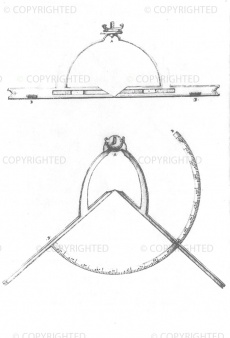Protractor
From Inventions
| (4 intermediate revisions not shown) | |||
| Line 29: | Line 29: | ||
| - | - The Science Museum, | + | - The Science Museum, London<br> |
[http://www.ingenious.org.uk/See/?s=S1&ObjectID={5B360CFF-E81D-9962-CB0B-17293CE3B67E}&source=Search&target=SeeMedium The Science museum, inv. 1915-388]<br> | [http://www.ingenious.org.uk/See/?s=S1&ObjectID={5B360CFF-E81D-9962-CB0B-17293CE3B67E}&source=Search&target=SeeMedium The Science museum, inv. 1915-388]<br> | ||
[http://www.ingenious.org.uk/See/?target=SeeMedium&ObjectID={053349A4-3050-CE37-5644-60E3D9F97689}&s=S1&SearchString=Protractor&source=Search&viewby=images&cntRead=0&cntDebate=0&cntDCBooks=0&cntDCImages=7& The Science museum, "Lusuerg protractor, 1701"]<br> | [http://www.ingenious.org.uk/See/?target=SeeMedium&ObjectID={053349A4-3050-CE37-5644-60E3D9F97689}&s=S1&SearchString=Protractor&source=Search&viewby=images&cntRead=0&cntDebate=0&cntDCBooks=0&cntDCImages=7& The Science museum, "Lusuerg protractor, 1701"]<br> | ||
| Line 43: | Line 43: | ||
http://il.youtube.com/watch?v=Xg9AUtOs96s&feature=related (a video on the invention of the protractor in English) | http://il.youtube.com/watch?v=Xg9AUtOs96s&feature=related (a video on the invention of the protractor in English) | ||
| - | |immagini= | + | |immagini=<gallery widths=230 heights=368 perrow=3> |
| + | |||
| + | Image: 56702.jpg | Giacomo Contarini. ''Figure d'Istromenti Matematici'', Oxford, c. 1590, c23.<br /> | ||
| + | |||
| + | </gallery> | ||
|autore_scheda= Filippo Camerota | |autore_scheda= Filippo Camerota | ||
Current revision as of 08:19, 10 September 2010
Name currently in use, deriving from the Greek gonia (angle) and metron (measure).
Contents |
Description
Generic name for instruments used to divide circles and measure plane angles. They can be circular, semicircular or rectangular. To increase its accuracy, the protractor was often inserted in a nonius, a device for enhancing the precision of the measurements made by a direct readout on a graduated scale. The instrument often came with other accessories, such as folding metal arms and plumb bobs. A singular variant for the layouts of fortresses is described by Giacomo Contarini as one of Fabrizio Mordente's inventions.
Bibliographical Resources
Contarini, Giacomo. Figure d'Istromenti Matematici e loro uso, ms, ca. 1590, Oxford, Bodleian Library, Ms. Canon. Ital. 145, c. 23.
Existing Instruments
- Museo Galileo, Institute and Museum of the History of Science, Florence
Florence, Museo Galileo. Institute and Museum of the History of Science, inv. 613.
Florence, Museo Galileo. Institute and Museum of the History of Science, inv. 1126, 612.
- Musée des arts et métiers, Paris
Paris, Musée des arts et metiers, inv. 21729-0001-
Paris, Musée des arts et metiers, inv. 21730-0000-
Paris, Musée des arts et metiers, inv. 02888-0000-
- The Science Museum, London
The Science museum, inv. 1915-388
The Science museum, "Lusuerg protractor, 1701"
- Museum of the History of Science, Oxford
Museum of the History of Science, Oxford, inv. 54238
Museum of the History of Science, Oxford, inv. 17159
Links (External)
http://il.youtube.com/watch?v=Xg9AUtOs96s&feature=related (a video on the invention of the protractor in English)
Images
Author of the entry: Filippo Camerota

